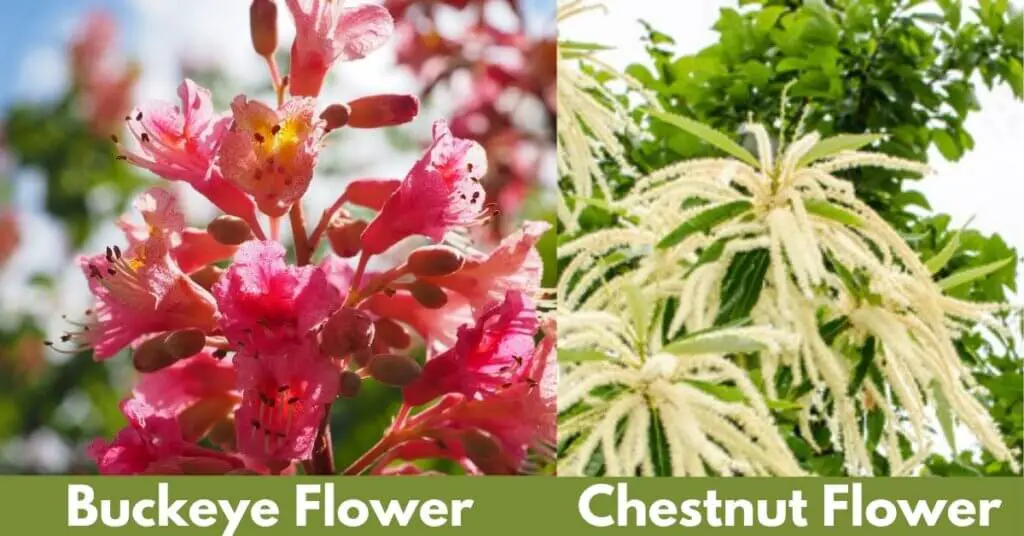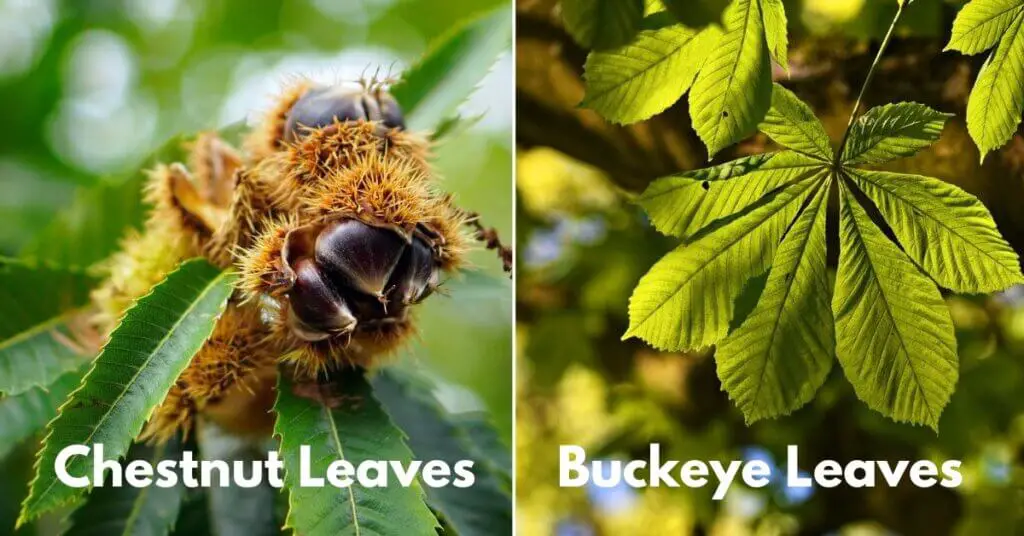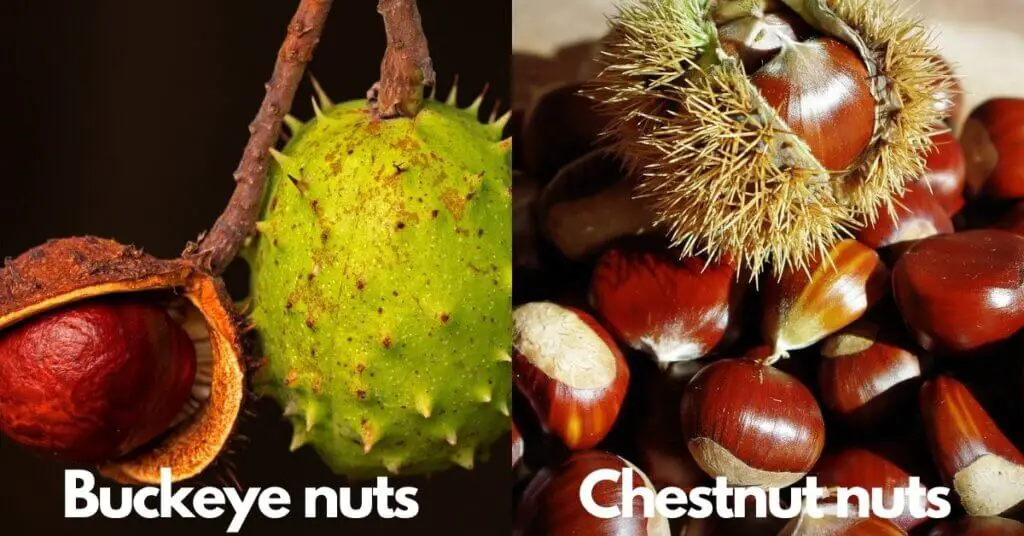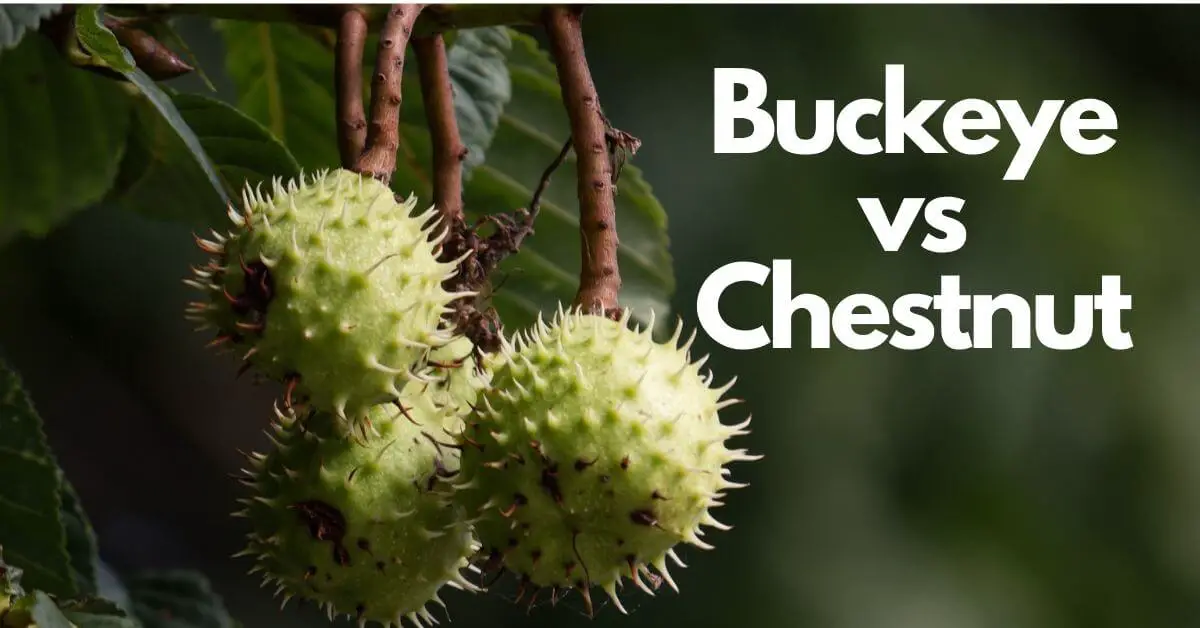Buckeye
The Buckeye tree is medium-sized growing. Commonly known as horse chestnut. They are native to North America. Its species range in size from 6- to 8-foot shrubs to massive 60-foot shade trees.
It has more than 20 species. But only 6 to 9 woody flowering species are famous. It is a tree-producing nut. Buckeyes aren’t produced true nuts, they are considered nut-like seeds. The nut-like seeds are shiny and dark brown, with a light-colored spot.
Chestnut
The chestnuts are the deciduous trees. They are native to the Northern Hemisphere. It produces edible nuts. There are eight or nine species of chestnut. It is similar to the other of all species. All species of chestnut produce both male and female flowers.
The four well-known species are American, European, Chinese, and Japanese chestnuts. The use of chestnuts depends on its species. Because each species has its own properties. All these species produce nuts.
| # | Buckeye | Chestnut |
| Scientific name | Aesculus | Castanea |
| Tree Height | 50 to 60 feet in height | 50 to 75 feet in height |
| Workability | Easy to Work | Easy To Work |
| Wood Grain Pattern | Fine, even texture | Grain is straight to spiral or interlocked |
| Wood Color | Creamy white or light yellow to nearby white | Pale white to light or dark brown |
| Durability | Not Durable | Very durable |
| Rot Resistance | Poor decay resistance | It is good rot resistant. |
| Type | Hardwood | Hardwood |
| Uses | Furniture, utility wood, boxes/crates, pulpwood | Home construction, cabinetry, furniture, utility poles, railroad ties, flooring, and musical instruments |
Buckeye vs Chestnut Uses
Best Uses of Buckeye
Boxes/Crates
To make perfect boxes or crates, the wood should be light and strong. Yellow buckeye is a suitable wood for making boxes.
Pulpwood
The paper industry is dependent on wood. The wood for pulpwood should have a soft and fine grain pattern. Ohio buckeye (stinking buckeye) and yellow buckeye are widely used for paper production.
Music instruments
The burl sections of yellow buckeye are used for electric guitar tops. A burl is a tree growth in which the grain has grown in a deformed manner. It is found on the outer side of the trunk. Random dark patterns are present in this part.
Best Uses of Chestnut wood
Flooring
Chestnut wood is considered a better option for flooring. Because hardwood wood is less prone to scratches and dents. But not all species of chestnut are suitable for flooring.
American Chestnut is the best species for durable flooring. Its Average Dried Weight is 30 lbs/ft3 (480 kg/m3) and Janka Hardness is 540 lbf (2,400 N). To prevent scratches and dents. You can put furniture leg pads under the furniture legs and Keep the pet’s nails short.
Shingles
Choosing wood to make a durable shingle can be challenging. Because shingles are constantly exposed to the external environment. Therefore the wood should be resistant to water, ultraviolet rays, insects, and moss resistance.
So once again, the American chestnut is widely used for making durable shingles. In earlier times the bark of American chestnuts has been used as shingles.
Common uses of Buckeye and Chestnut wood
Furniture
Buckeye has poor decay resistance. But because of its lightweight and strength. It can be used for interior furniture.
Chestnuts are naturally very durable, rot-resistant, straight-grained, and formerly plentiful. It is suitable for making quality furniture. It can also be easily stained. Oak is considered as an alternative to the chestnut. Because the properties of chestnut and oak are very similar to each other.
Carving
Buckeye and Chestnuts are generally easy to work with. They can be easily curved and make great options to make small objects (wooden decorative items).
Buckeye vs Chestnut Rot Resistance
Buckeye is not rot-resistant. This is because it is not considered better for outdoor uses. When it comes in contact with moisture and soil, it starts to rot.
On other hand, Chestnut is Rated as very durable, and naturally rot-resistant. It can be used for outdoor and indoor applications.
Workability
Buckeye and Chestnut are generally easy to work with hand and machine tools. Chestnut splits easily, so pay attention when nailing and screwing. Pre-drilling will be better for nailing and screwing. Glues, stains, and finishes well.
Buckeye has interlocked grain that can lead to fuzzy surfaces. That’s why you may have some difficulty during planning. Buckeye is one of the poorest woods for steam bending. But Glues and finishes well.
Buckeye tree vs a Chestnut Tree
Buckeye trees are medium-sized trees that grow 12 to 40 ft. (3.5 – 12 m) tall. Its trunk diameter can be 1.5-2 ft (.5-.6 m). It grows 12″ to 24″ per year. You can often find it in the park or backyard. Buckeye does well with silty clay loam, rich in organic matter, slightly acidic, and moist but well-drained soil.
Chestnut trees are large deciduous trees. Chestnut trees are fast-growing trees that grow 24 to 36 inches (2 to 3 feet) per year. The height of a healthy tree is 60 to 80 ft. (18 – 24m). Chestnut trees prefer sandy, loamy, well-drained, and somewhat acidic soil (pH 4.5-6.5).
Buckeye vs Chestnut Flowers

Buckeye flowers
The Buckeye is a flowering tree in the form of conical clusters. Flowers are creamy yellow to green petals. While red buckeye (Aesculus Pavia) produces red flowers and yellow buckeye (Aesculus Flava) produces yellow flowers.
The panicles can contain around 70 to 80 flowers and grow up to 6″ (15 cm) long. In full bloom during April and May.
Chestnut Flowers
Flowers appear in late spring or early summer or from June to July. They are arranged in long catkins. The flowers are creamy-white that give off a strong, sweet aroma.
Bark
Buckeye Bark
The bark of a young tree is light to dark-gray-brown, later it becomes rough. But the color always remains lighter.
Chestnut Bark
Young chestnut trees have smooth, reddish-brown, or grey bark, but furrowed with age.
Buckeye vs Chestnut leaves

Buckeye Leaves
The leaves of buckeye are palmately compound with five (rarely seven) leaflets. Each leaflet is an elliptic or ovate shape. It is 3” and 12” (8 – 30 cm) long. The color and size of leaves depend on their species. Yellow Buckeye and California Buckeye leaves are dark green and Ohio Buckeye leaves are light and shine green.
Chestnut Leaves
Leaves are ovate or lanceolate-shaped with sharply pointed leaves. It is 6” and 10” (15 – 25 cm) long and up to 4” (10 cm) wide. It is yellowish-green in the beginning and turns a golden yellow in the fall before the leaves drop. The leaf is dull or “matte” rather than shiny.
Buckeye vs Chestnut Nuts

Buckeye nuts
Nuts are rounded, oval, shiny brown nut-like seeds with cream-colored spots. It is inside a shell, which can be peeled off by hand. Their diameter is about 1.2″ (3 cm).
Some people use Buckeye nuts as a lucky charm. Nuts can be collected in late summer after they turn a leathery tan color.
Chestnut nuts
Chestnut nuts are very similar to buckeye nuts. While cultivated or American, European, Chinese, and Japanese are edible, horse chestnuts are toxic. Eating them can cause pain, nausea, and vomiting, or throat irritation.
Chestnut trees start producing nuts only after 3-5 years of age. A 10-year-old tree can produce as much as 10-20 lbs/tree.
Can you eat a buckeye and how?
Generally, Buckeys’ nuts are not edible, Nuts and their shells are pretty toxic to humans and animals. Consuming it can be dangerous. The other parts of these plants are also poisonous. Such as leaves, and even the bark of the tree is known to have caused illness.
You have to remove the shells and roast or mash them before eating nuts.
How to eat chestnuts?
Chestnuts nuts contain tannic acid content. Which can be harmful to humans and animals. Therefore must always be cooked before use. You need to remove the nuts from their skins. It can be easily peeled by boiling or roasting.

